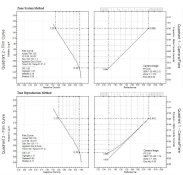Stephen Benskin
Member
No matter how much you think you understand something, any feelings of complacency are shattered when you have to explain it to someone else. They say no one learns more in a classroom than the teacher. And that pretty much sums it up when I was teaching a class and the lesson was on the Zone System. Like many people, I started with the Zone System, but soon I moved onto more scientific versions of sensitometry and tone reproduction.
When it came time to teach, I had to finally face certain concepts that didnt seem to match up between what I learn about sensitometry and what the Zone System was explaining. One of these dilemmas is on how to define a normal negative. The basic idea is to process the negative so that the negative density range will fit onto the papers log exposure range. While sensitometry uses the method that is described in Chucks thread Testing for Relative ISO Range Numbers, the Zone System has a set of density aim values for the negative to fit onto a grade 2 paper.
According to sensitometric and tone reproduction theory, a paper with an LER of 1.05 is considered a grade 2 paper; therefore, a negative with a density range of 1.05 should fit nicely onto the paper.
According to Zone System theory, the negative density range for a grade 2 paper is 1.25 (1.35 0.10). Sensitometric theory says that is the range for a grade 1 paper and not a grade 2 paper.
Obviously one has to be wrong. Since a negative with a density range of 1.25 will be too contrasty for a LER 1.05 grade 2 paper, it must be the Zone Systems approach that is incorrect. Except that in practice, both methods seem to work. Thus the dilemma.
Some people dont seem to have problems not questioning such differences. Personally, I had blown off the Zone System values as coming from a less precise, less sophisticated method. That is until I had to explain it and why it still worked. I had to ask myself how two seemingly dissimilar methods that had different stated aim values could produce similar results.
Theres a good reason for it and an important lesson that should be kept in mind by everyone when testing.
When it came time to teach, I had to finally face certain concepts that didnt seem to match up between what I learn about sensitometry and what the Zone System was explaining. One of these dilemmas is on how to define a normal negative. The basic idea is to process the negative so that the negative density range will fit onto the papers log exposure range. While sensitometry uses the method that is described in Chucks thread Testing for Relative ISO Range Numbers, the Zone System has a set of density aim values for the negative to fit onto a grade 2 paper.
According to sensitometric and tone reproduction theory, a paper with an LER of 1.05 is considered a grade 2 paper; therefore, a negative with a density range of 1.05 should fit nicely onto the paper.
According to Zone System theory, the negative density range for a grade 2 paper is 1.25 (1.35 0.10). Sensitometric theory says that is the range for a grade 1 paper and not a grade 2 paper.
Obviously one has to be wrong. Since a negative with a density range of 1.25 will be too contrasty for a LER 1.05 grade 2 paper, it must be the Zone Systems approach that is incorrect. Except that in practice, both methods seem to work. Thus the dilemma.
Some people dont seem to have problems not questioning such differences. Personally, I had blown off the Zone System values as coming from a less precise, less sophisticated method. That is until I had to explain it and why it still worked. I had to ask myself how two seemingly dissimilar methods that had different stated aim values could produce similar results.
Theres a good reason for it and an important lesson that should be kept in mind by everyone when testing.








 Mine is 3mm but the optional 1mm opening could still allow 50 leaves and part of a tree...and that is on one of my 8x10 negatives. For 35mm that 3mm could easily encompas an entire automobile and part of the road, etc....
Mine is 3mm but the optional 1mm opening could still allow 50 leaves and part of a tree...and that is on one of my 8x10 negatives. For 35mm that 3mm could easily encompas an entire automobile and part of the road, etc....


